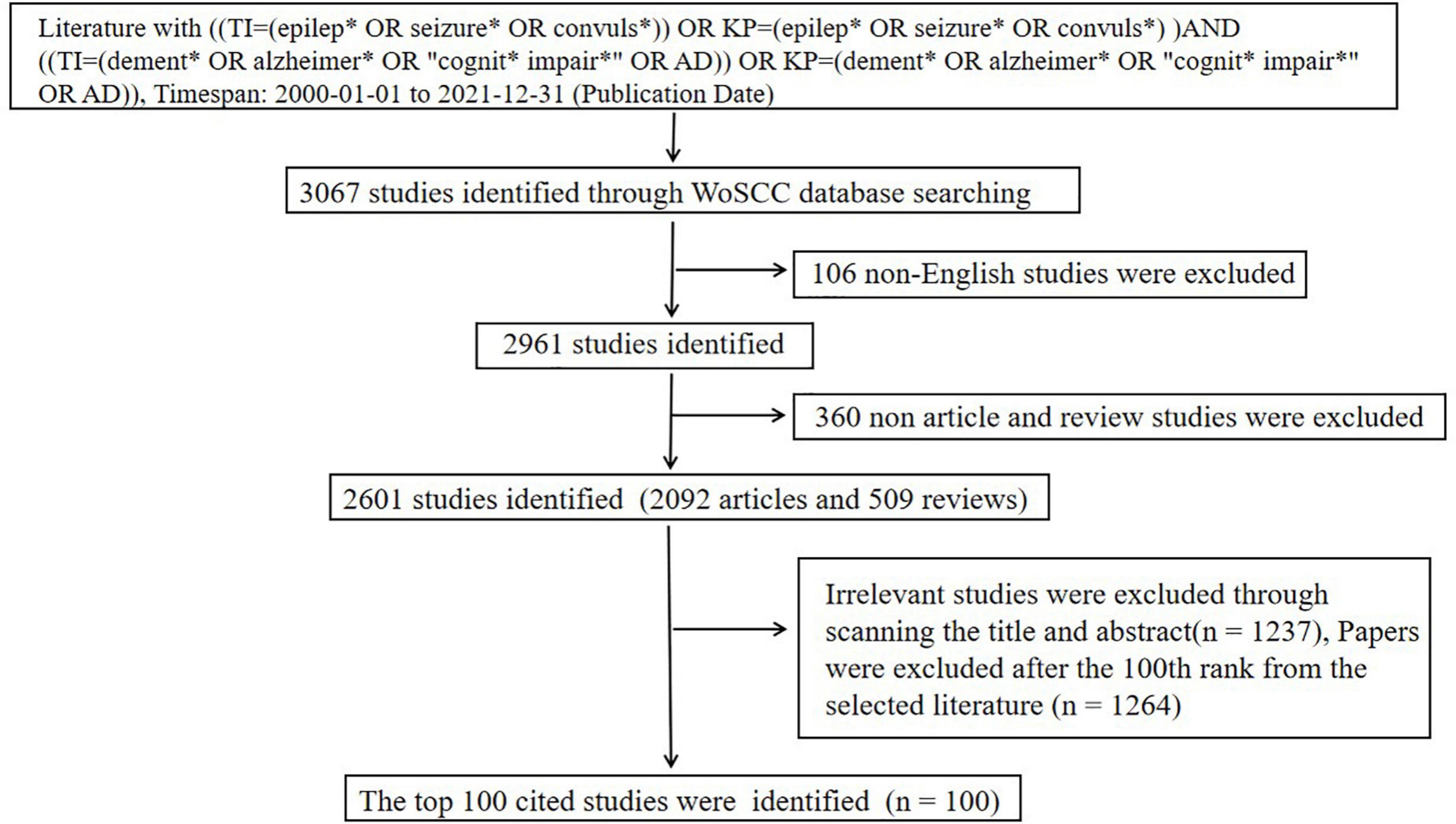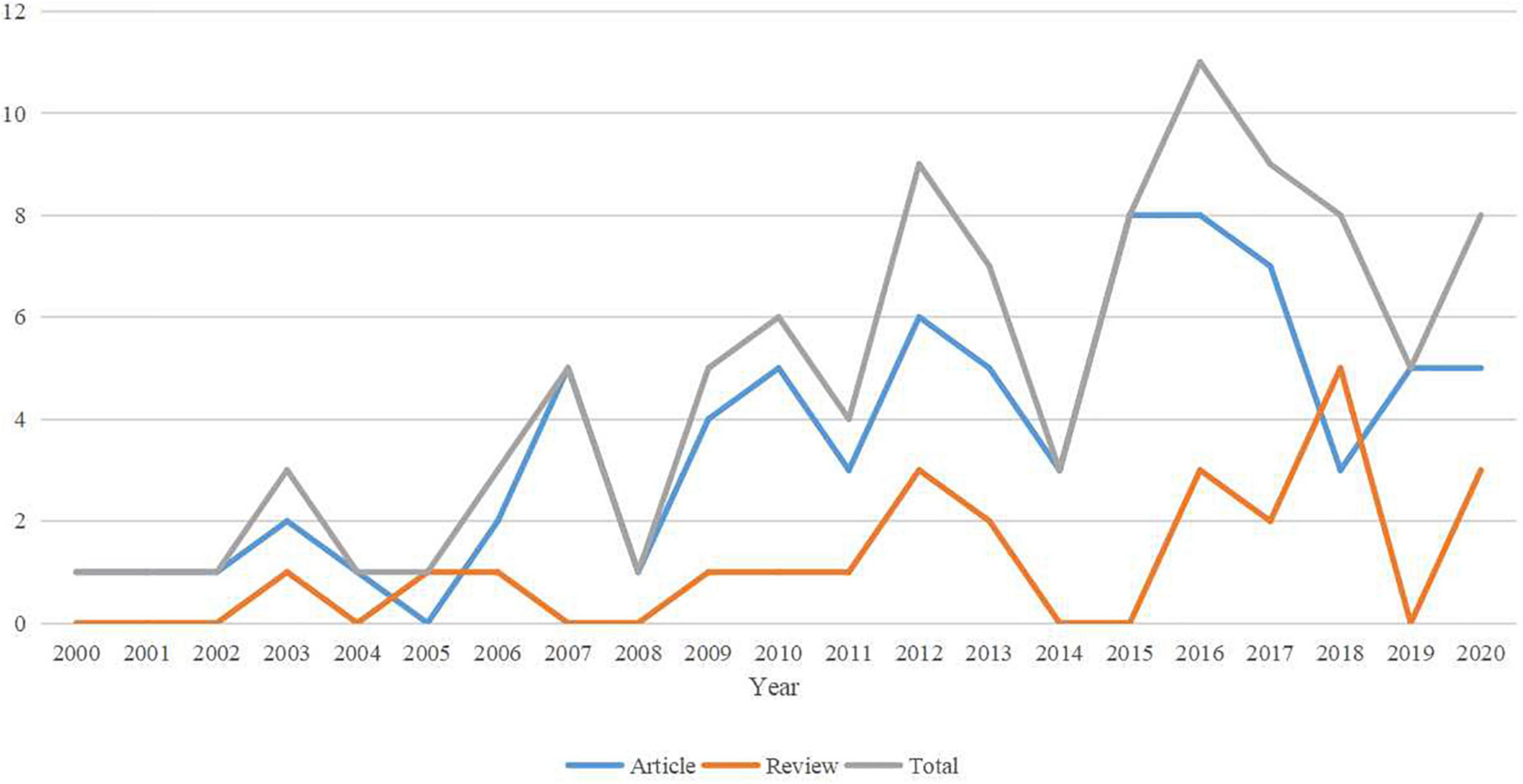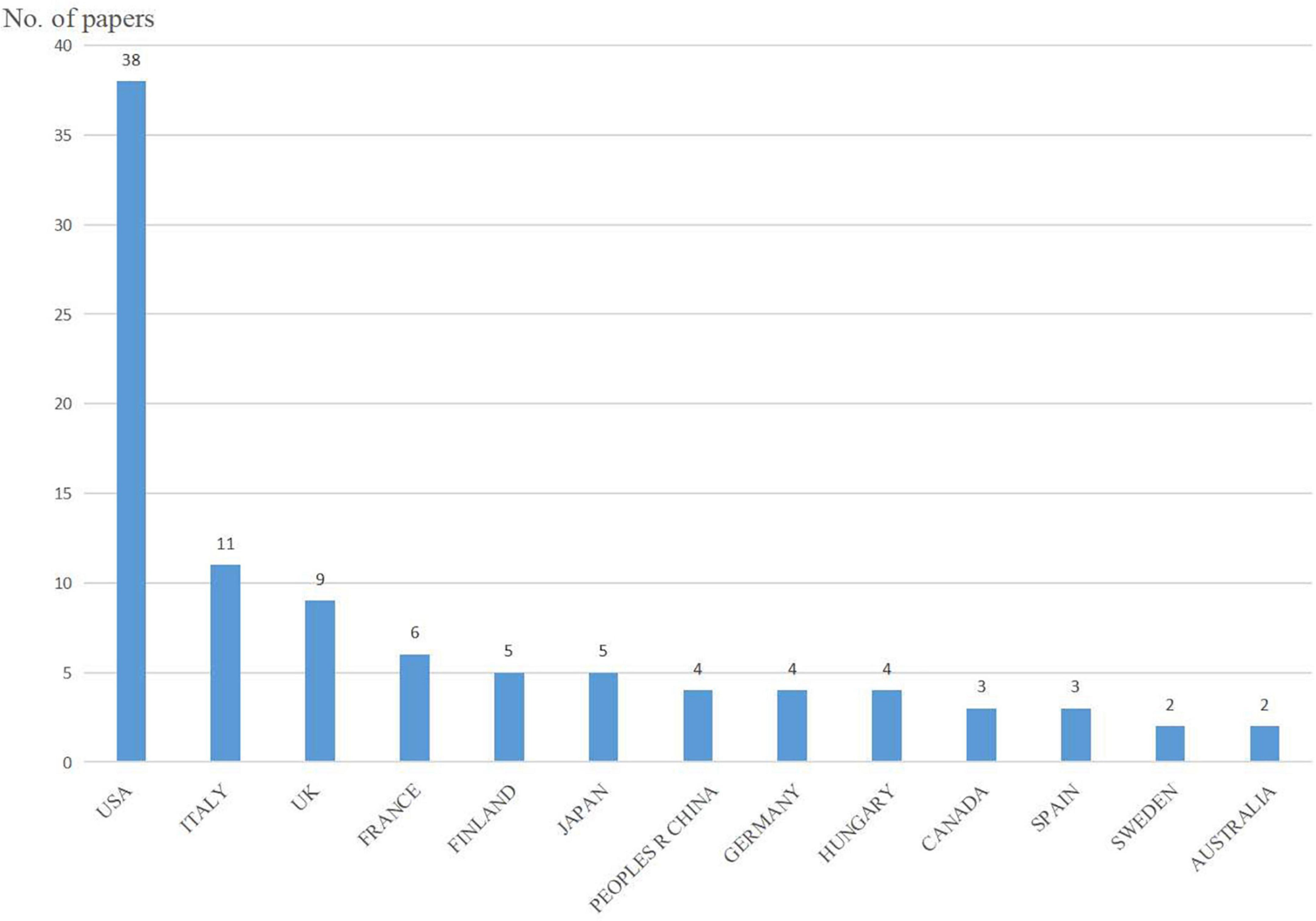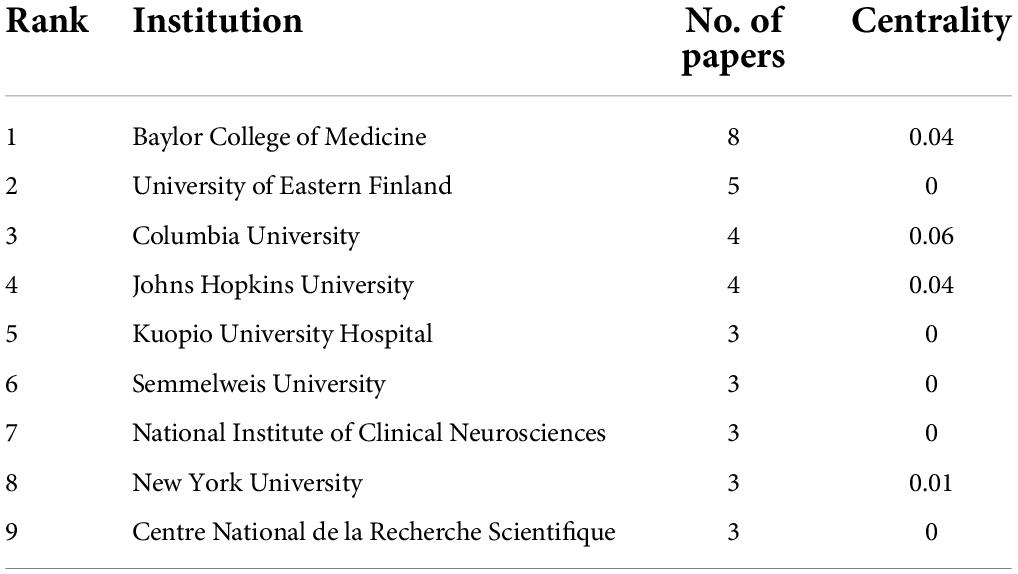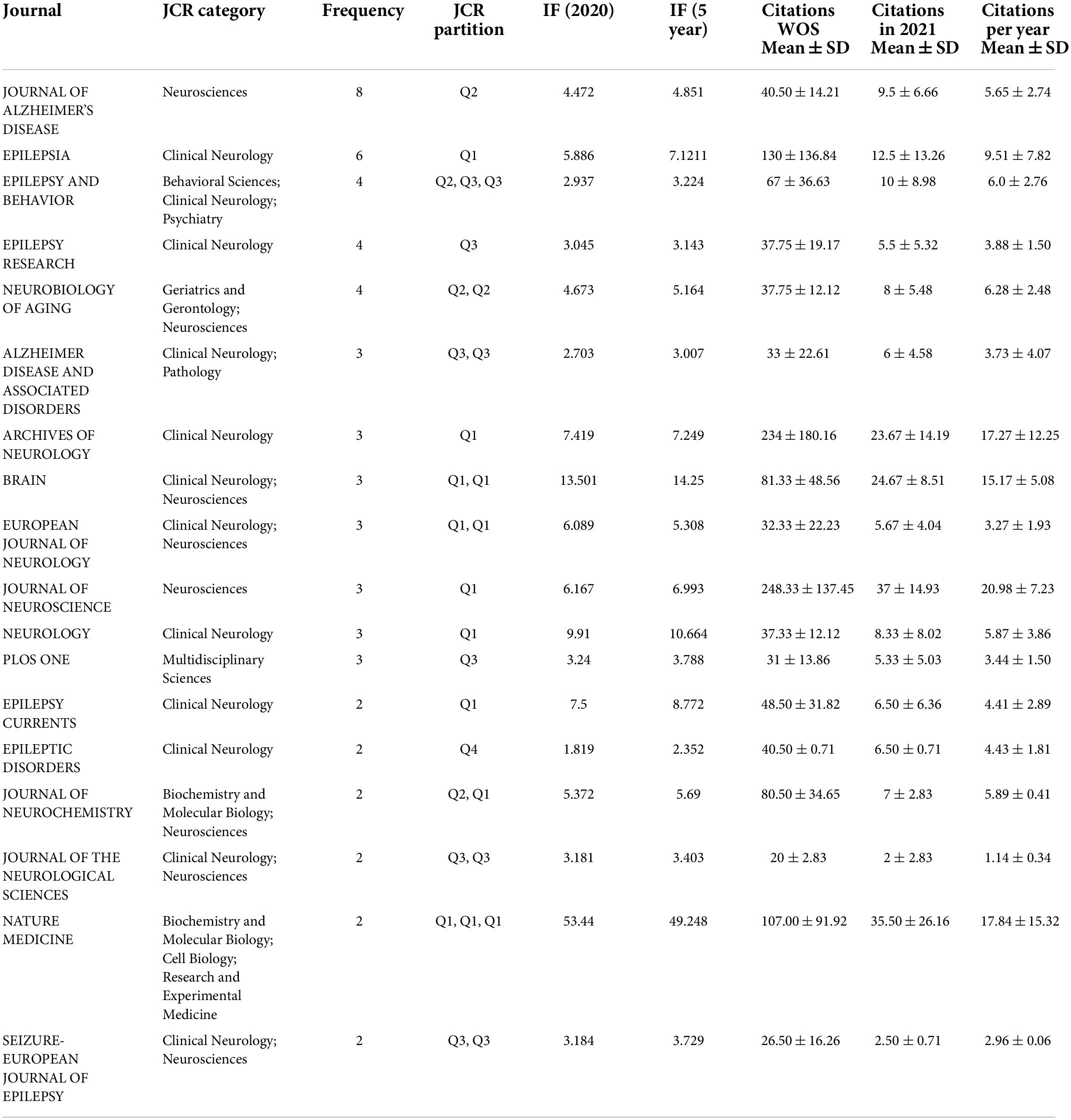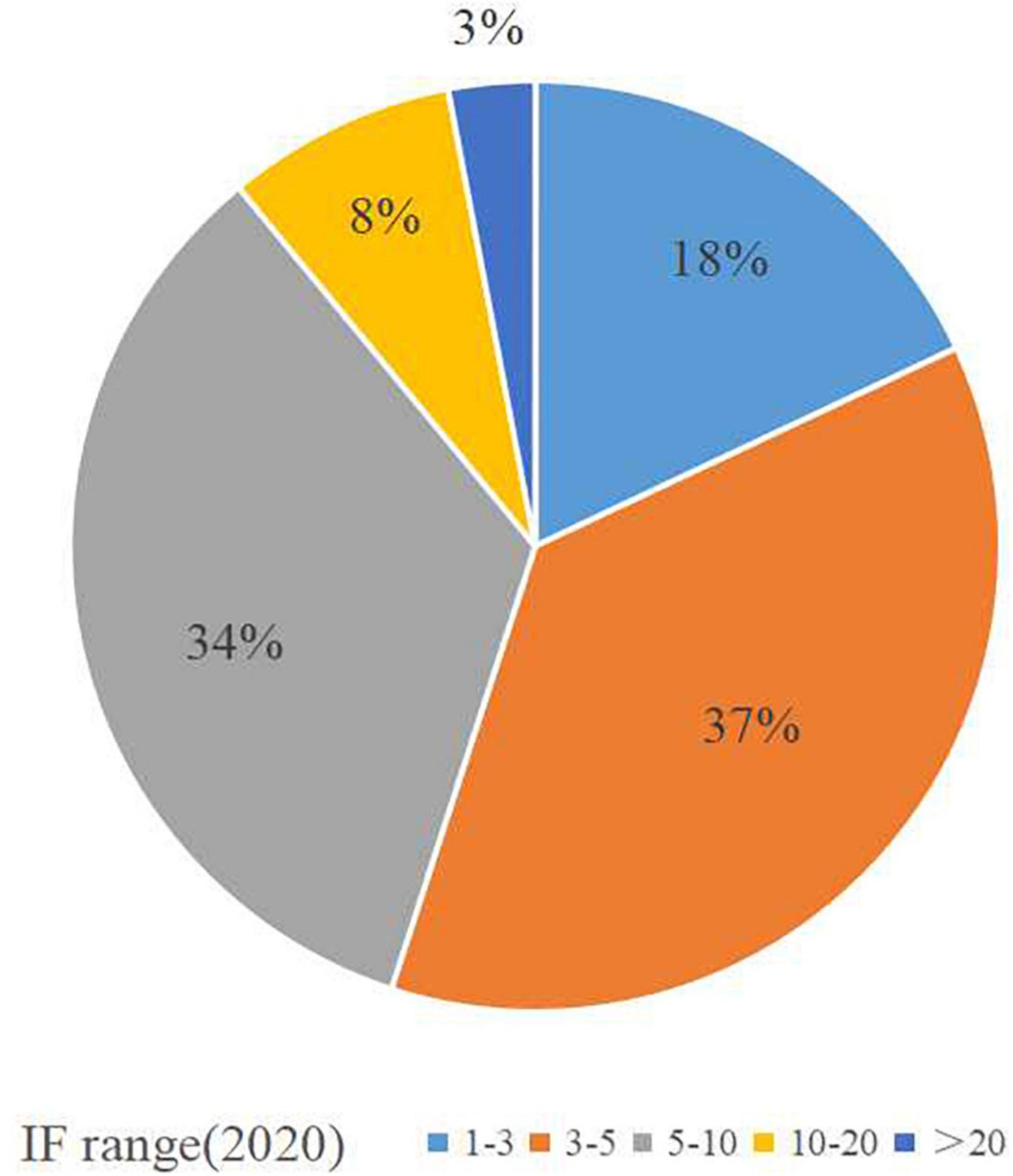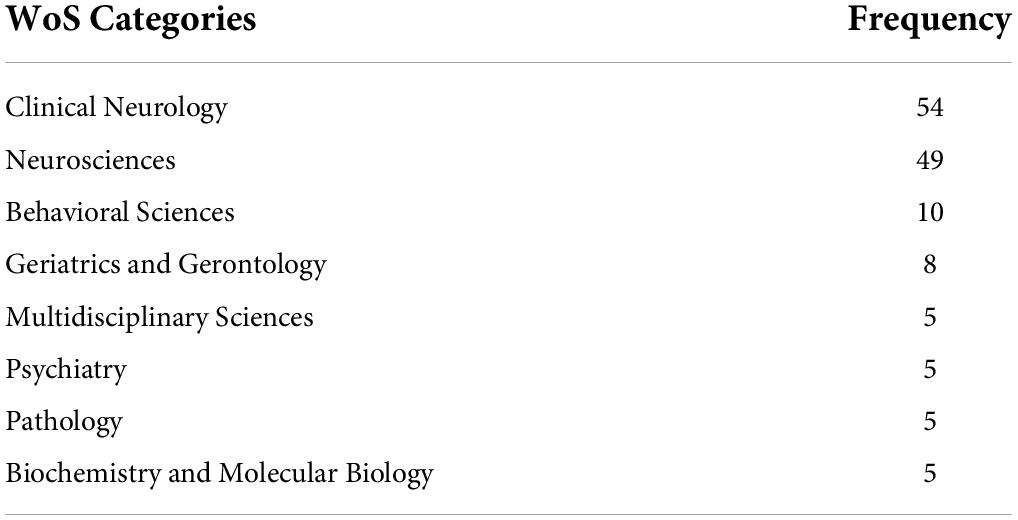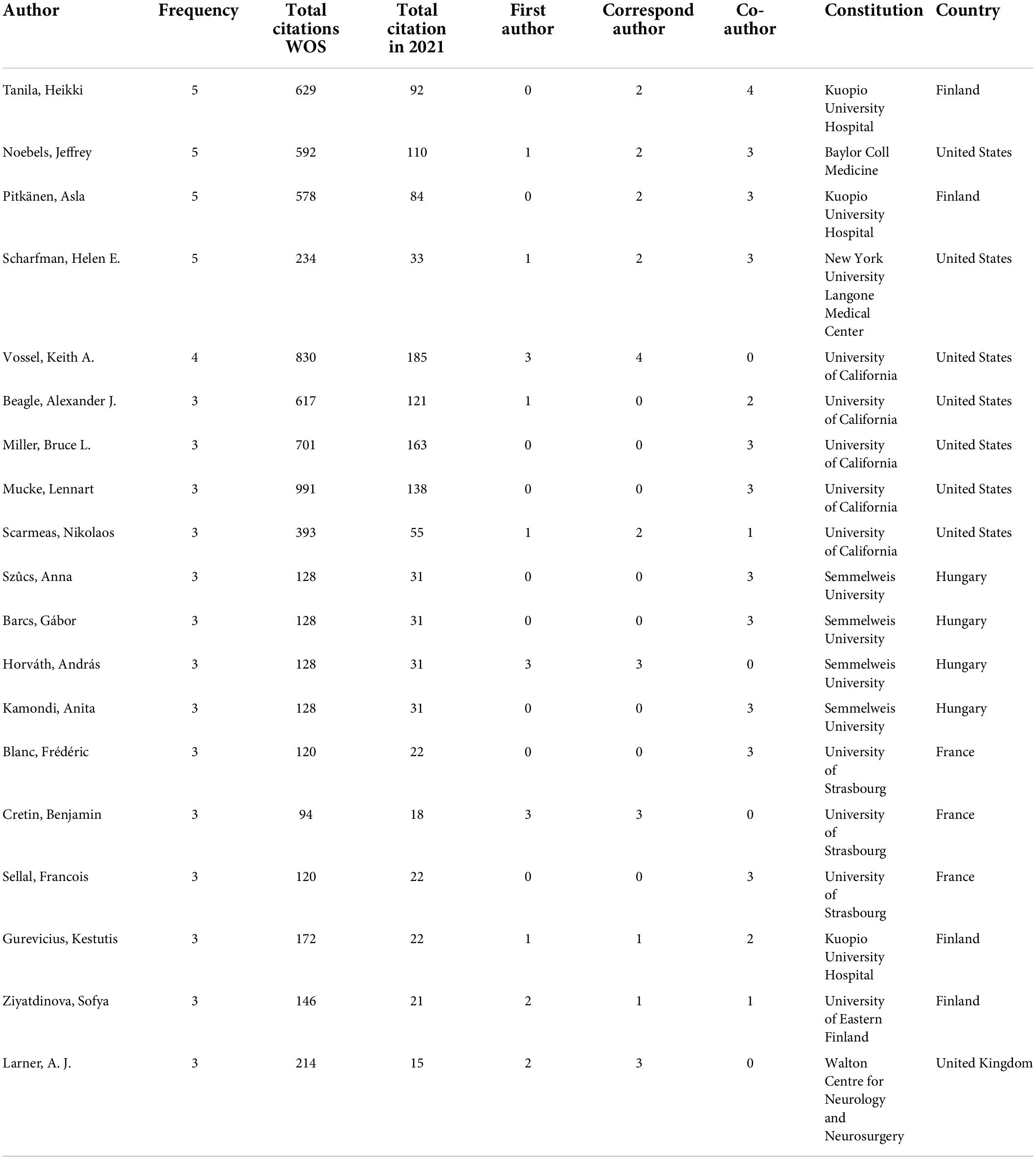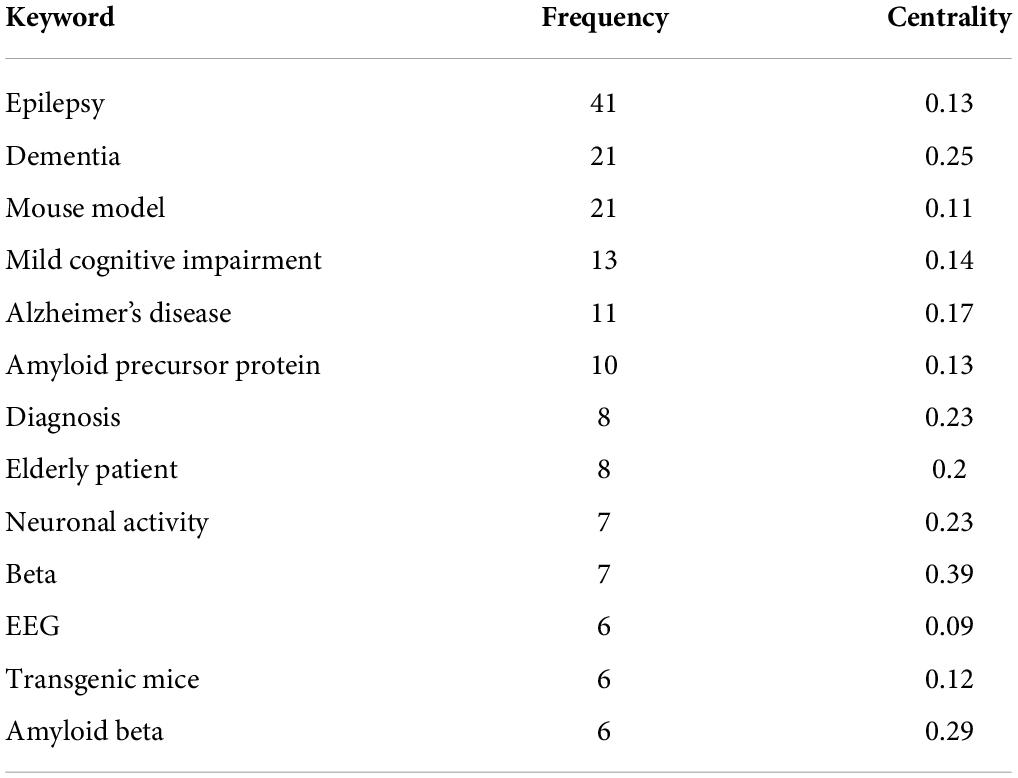- 1Department of General Practice and International Medicine, Second Affiliated Hospital, School of Medicine, Zhejiang University, Hangzhou, China
- 2Department of Neurology, Epilepsy Center, Second Affiliated Hospital, School of Medicine, Zhejiang University, Hangzhou, China
Background: Alzheimer’s disease (AD) is one of the common neurodegenerative diseases, which often coexists with epilepsy. It is very significant to study the treatment options and the relationship between AD and epilepsy.
Aims: The purpose of this study was to analyze the top 100 cited papers about AD and epilepsy using bibliometrics, and to describe the current situation and predict research hot spots.
Methods: Top 100 papers were obtained from the Web of Science Core Collection (WoSCC). The WoSCC was used to analyze the author, institution, country, title, keywords, abstract, citation, subject category, publication year, impact factor (IF), and other functions. SPSS25 software was used for statistical analysis and CiteSpace V.5.7.R2 was used to visualize the information through collaborative networks.
Results: The number of publications gradually increased from 2000 to 2021. The total citation count for the top 100 papers ranged from 15 to 433(mean = 67.43). The largest number of papers were published in 2016 (n = 11). Meanwhile, USA (centrality: 0.93) and Columbia University (centrality: 0.06) were the most influential research country and institutions, respectively. The top contributing journals was Journal of Alzheimer’s Disease (8%). The IF for journals ranged from 1.819 to 53.44. A network analysis of the author’s keywords showed that “beta” (centrality: 0.39), “amyloid beta” (centrality: 0.29), “hyperexcitability” (centrality: 0.29) and “disease” (centrality: 0.29) had a high degree of centrality.
Conclusion: AD and epilepsy have been intensively studied in the past few years. The relationships, mechanisms and treatment of AD and epilepsy will be subjects of active research hotpots in future. These findings provide valuable information for clinicians and scientists to identify new perspectives with potential collaborators and cooperative countries.
Introduction
Alzheimer’s disease (AD) and epilepsy are common neurological diseases. The number of patients with dementia and epilepsy in the global population is increasing, representing a growing problem for global health. The overall lifetime prevalence of epilepsy is 7.60 per 1,000 population [95% confidence interval (CI) 6.17–9.38] and the prevalence of epilepsy tends to peak in the elderly (Beghi, 2020). The prevalence of AD in Europe was estimated at 5.05% (95% CI, 4.73–5.39), and similar to epilepsy, AD prevalence increases with age (Niu et al., 2017). In fact, these two diseases are related. Epilepsy occurs more frequently in patients with AD than in those with non-Alzheimer’s disease (Samson et al., 1996). Recent findings showed that seizures could accelerate the decline of cognitive ability in patients with AD and that there might be an important bidirectional relationship between epilepsy and AD (Sen et al., 2018). AD and Epilepsy also share many pathological similarities (Lehmann et al., 2021), e.g., temporal lobe atrophy, neuronal death, gliosis, neuritic alterations, and neuroinflammation (Struble et al., 2010). In addition, AD plus epilepsy would lead to more serious clinical consequences, such as cognitive decline, weakness, anxiety, depression, social withdrawal, psychological and behavioral comorbidity, and poor treatment compliance (Cretin, 2021). Overtime, a large amount of literature has been published comprising a wide range of relevant research and clinical themes. However, the precise mechanisms leading to the development of seizures in the setting of AD are still under investigation and require further study. A meta-analysis showed that the quality of evidence on the treatment outcome of epilepsy in patients with AD was very low (Liu and Wang, 2021).
As a discipline emerging since its formal foundation, a bibliometric review of the literature was warranted to aid the synthesis and implementation of the evidence base. Despite citation analysis across a broad range of neurosciences (Yeung et al., 2017), there is limited information in the field of AD and epilepsy, with few published studies. Citation counting is an important metric to understand the significance of the contribution of research to a research field (Fox et al., 2021). Previous reviews only relied on individuals to study the research through literature summary and extraction, and thus cannot fully reflect the temporal and spatial distribution of researchers, institutions, and journals. Moreover, it is difficult to visualize the internal structure of the knowledge base and research focus, and systematic, comprehensive, and visual research are rarely found. Therefore, the present study aims to comprehensively analyze the current status, research hotpots, and development trends through a bibliometric analysis of the top 100 papers on AD and epilepsy published from 2000 to 2021. The findings may help follow-up researchers study the association between AD and epilepsy, identify journal publications and collaborators, and analyze keywords and research trends, which might promote research aiming to determine the cause, mechanism, and treatment of the disease.
Materials and methods
Data source
The retrieval data for measurement and statistical analysis were screened from the Web of Science Core Collection (WoSCC), which provided the citation search, giving access to multiple databases that reference cross-disciplinary research and allowing an in-depth exploration of specialized subfields (Wu et al., 2021). We conducted a literature search from the WoSCC on June 5th, 2022. In this study, the search criteria in the WoSCC database were as follows: ((TI = (epilep* OR seizure* OR convuls*)) OR KP = (epilep* OR seizure* OR convuls*)) AND ((TI = (dement* OR Alzheimer* OR “cognit* impair*” OR AD)) OR KP = (dement* OR Alzheimer* OR “cognit* impair*” OR AD)). Timespan: 2000-01-01 to 2021-12-31 (Publication Date). Document type: articles and reviews; Language: English. A total of 2601 records were retrieved. Then, two independent investigators reviewed the titles and abstracts and deleted studies that were not associated with AD and epilepsy, which excluded 1237 papers according to the criteria (Guo et al., 2021). And 1264 papers were excluded after the 100th rank from the selected literature. Finally, the top 100 studies were determined. A Preferred Reporting Items for Systematic Reviews and Meta-Analyses (PRISMA) flow diagram for the WoSCC results is provided in Figure 1.
Data analysis
In the present study, WoSCC was used to analyze the author, institution, country, title, keywords, abstract, citation, subject category, publication year, impact factor (IF), and other functions. The selected documents were imported into Excel (Microsoft Corporation, Redmond, WA, United States) and CiteSpace 5.8.R3 (64-bit) (Palop and Mucke, 2009). SPSS 25.0 statistical software (IBM Corp., Armonk, NY, United States) was used for statistical analysis. Continuous variables were expressed as the mean ± SD. Categorical variables were expressed as a percentage. CiteSpace, a bibliometric analysis tool, was created by Dr. Chaomei Chen (School of Information Science and Technology, Drexel University, Philadelphia, PA, United States) and his team. It visualizes countries/regions, institutions, authors and their cooperative relationships, co-cited references, and co-occurrence words through collaborative networks, which has been widely used in biomedical research fields.
Three folders of the research were created, including input folder placing the data downloaded from WoSCC, a data folder containing the data after deleting duplicate documents, and a project folder containing the data processed by cite. We did not find duplicate documents that needed to be deleted. The overall selected time span was from January 2000 to December 2021. Then, the slice length was set as 2 years. The node type was selected according to the type of analysis performed. The link lines between the nodes indicated the collaborative relationships. The size of the circles represented the number of papers published by the country/region, institute, or author. Purple rings indicated that these countries/regions, institutes, or authors had greater centrality.
Results
The 100 most-cited publications
We retrieved the 100 most frequently cited papers related to AD and epilepsy. The results were ranked according to citation counts to represent the 100 most-cited publications (76 articles and 24 reviews). A comprehensive list of the 100 publications and a citation details are presented in the Table 1.
As shown in Table 1, The 100 most-cited articles received a total of 6743 citations (according to Web of science, WOS). The median number citations was 39, with a range of 15–433. For annual citations, the mean value was 7.41 with a range of 0.8–35.70. Seventeen papers were cited more than 100 times, and 36 were cited more than 50 times. The review entitled “Epilepsy and Cognitive Impairments in Alzheimer Disease” from Palop and Mucke (2009) was the most-cited publication (n = 433).
Publication years
As shown in Figure 2, the top 100 most-cited papers were published from 2000 to 2020. Overall, publications showed a fluctuating upward trend. The largest number of studies was published in 2016 (n = 11), including eight articles and three reviews. The number of papers published in 2011 was higher than the number of papers published between 2000 and 2010.
Contributions of countries
Overall, 22 countries contributed to the included studies, with nine countries publishing only one study. The United States was the largest contributor of studies (38%), followed by Italy (11%) and the United Kingdom (9%). The contributing countries are shown in Figure 3.
Generating a country map using CiteSpace resulted in 22 nodes and 44 links (Figure 4). The 100 papers were published by research groups in 22 countries. The top five countries were the United States, Italy, the United Kingdom, France, and Finland. The top three countries in terms of centrality were the United States (0.93), the United Kingdom (0.44), and France (0.21). An analysis in terms of publication and centrality indicated that the United States, the United Kingdom, Italy, and France were the main research powers in this research. United States has established cooperation with 12 countries, and the strongest collaborations were identified between United States, Canada, Israel, Greece, India, and Switzerland.
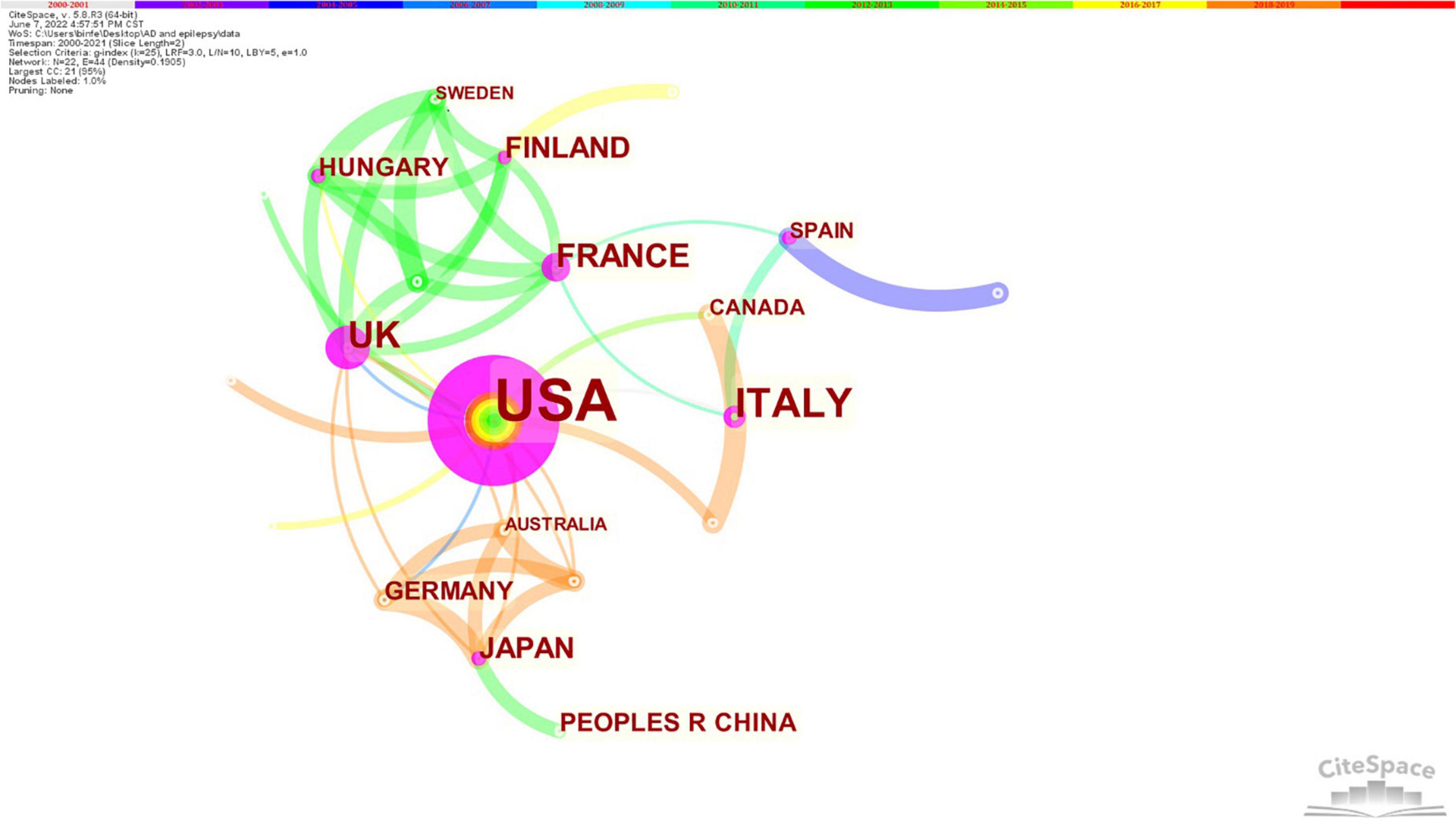
Figure 4. Contributions of countries. Purple rings indicated that these countries/regions had greater centrality (no less than 0.1). The size of the circle represents the number of papers published by the country. The shorter the distance between two circles, the greater the cooperation between the two countries. United States was the most influential research country.
Contributions of institutions
A total of 178 institutions published at least one top-cited paper, the distribution of institutions was very scattered, with 21 (11.80%) institutions publishing two papers and 148 (83.15%) institutions publishing only one paper. A small number of institutions accounted for a high proportion of the highest cited papers. Table 2 shows that the top nine institutions collectively published at least three papers. Baylor College of Medicine from United States topped the list with eight papers.
Figure 5 shows that generating an institution map resulted in 149 nodes and 308 links. The top 100 publications were distributed among 149 research institutions. The top five institutions were Baylor College Medicine, University of Eastern Finland, Columbia University, and Johns Hopkins University and Kuopio University Hospital. The top four institutions in terms of centrality were Columbia University (0.06), Baylor College of Medicine (0.04), Johns Hopkins University (0.04) and Indiana University (0.03). Analysis in terms of centrality indicated that Columbia University was the most influential research institution.
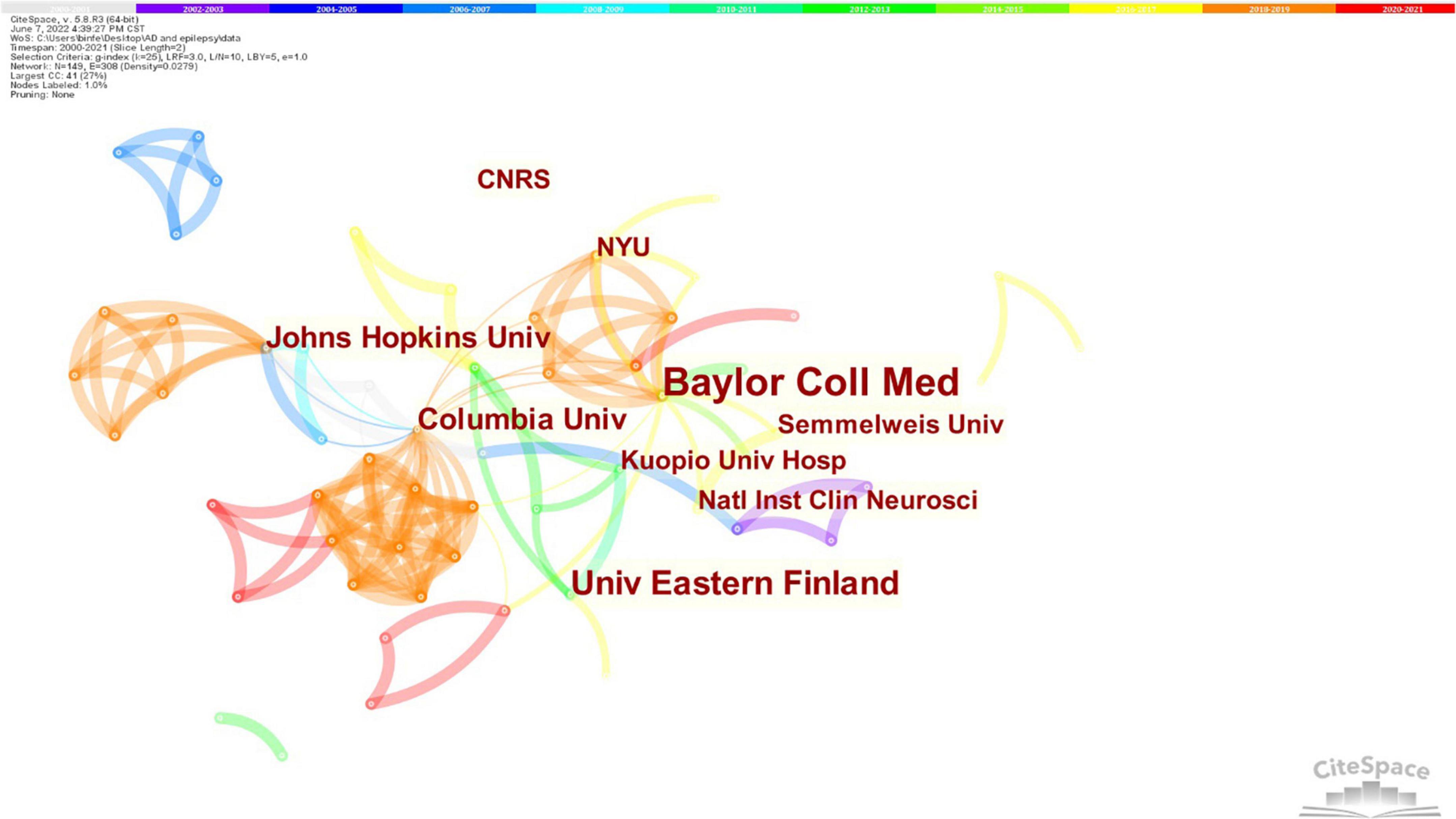
Figure 5. Contributions of institutions. Nodes represent institutes, and the size of each node corresponds to the co-occurrence frequency of the institutes. The size of the circle represents the number of papers published by the institute. The shorter the distance between two circles, the greater the cooperation between the two institutes. Columbia University was the most influential research institutions.
Distribution of journals
The 100 most-cited articles were published in 59 journals; 18 journals published more than one study, which were distributed in the four partitions of Journal Citation Reports (JCR) (McVeigh, 2008). The JCR data provide both detailed journal information and flexible context, and category information to allow people to understand the way each journal functions in the literature. The major contributing journals are presented in Table 3. The top five journals that published the 100 most-cited AD and epilepsy studies included Journal of Alzheimer’s Disease (n = 8), Epilepsia (n = 6), Epilepsy and Behavior (n = 4), Neurobiology of Aging (n = 4) and Epilepsy Research (n = 4). With regard to the average citation number per paper, Journal of Neuroscience ranked first with a mean of 20.98 citations per paper, followed by Nature Medicine, with a mean of 17.84.
The IF for journals in the top 100 most-cited papers ranged from 1.819 to 53.44, among which 37 journals had an IF between 3 and 5, 34 journals had an IF between 5 and 10, and 3 journals had an IF above 20 (Figure 6).
In Table 4, the top 100 papers were classified into different study fields on the basis of WOS categories. The leading WOS category was “Clinical Neurology” (n = 54), following by “Neurosciences” (n = 49) and “Behavioral Sciences” (n = 10).
Major contributing authors
Overall, a total of 606 authors contributed to the 100 studies. There was wide, disparate authorship of first authors, with 90 different first authors represented in the 100 included publications. A total of four contributors published the most articles, namely Tanila Heikki, Noebels Jeffrey, Pitkänen, Asla and Scharfman, Helen E, who all published five publications, the total number of citations for the papers were 629, 592, 578, and 234 respectively. Only three authors have published three studies as a first author. Keith A. Vossel from the University of California, as a first author and corresponding author, had the largest number of total citations in 2021 (n = 185). Table 5 presents results for authors who contributed three or more of the 100 most-cited papers.
Analysis of co-occurring keywords
CiteSpace was used to extract the keywords from the top 100 papers on AD and epilepsy. A network analysis of the author’s keywords or subject words was carried out during the publication time of the articles, namely, 2000–2021. Table 6 shows that the top five keywords are epilepsy (n = 41), dementia (n = 21), mouse model (n = 21), mild cognitive impairment (n = 13), and Alzheimer’s disease (n = 11). The greater the centrality value, the more cooperation between the node and other nodes. Figure 7 shows that “beta” (centrality: 0.39), “amyloid beta” (centrality: 0.29), “hyperexcitability” (centrality: 0.29) and “disease” (centrality: 0.29) had a high degree of centrality during this period. A comprehensive analysis of centrality showed that “beta” (n = 7, centrality: 0.39), “disease” (n = 3, centrality: 0.29), “dementia” (n = 21, centrality: 0.25) and “brain” (n = 4, centrality: 0.25) are the most influential keywords in this field.
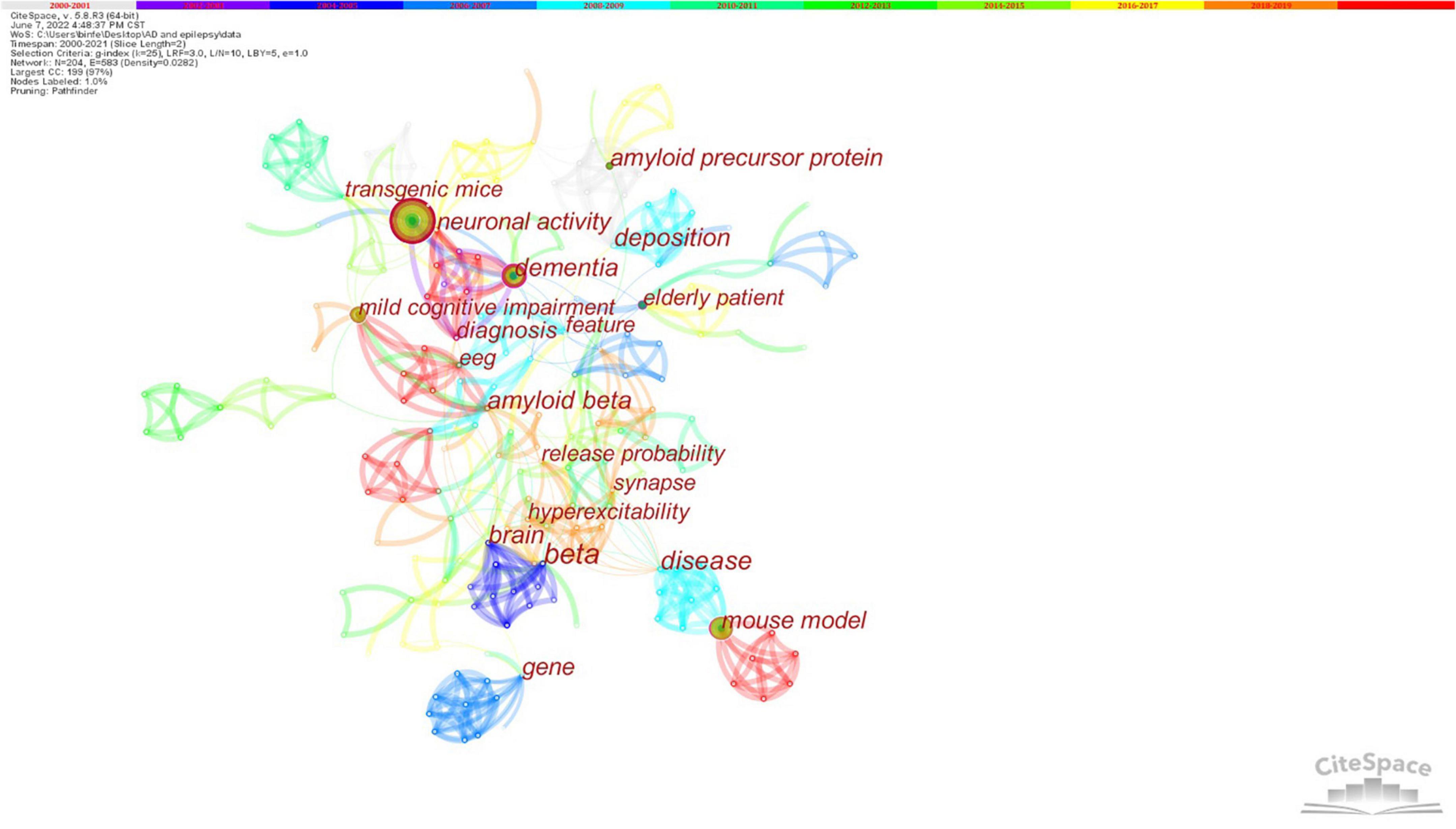
Figure 7. Analysis of co-occurrence Keywords. Nodes represent keywords, and the size of each node corresponds to the co-occurring frequency of the keywords. The color of the lines that appear together between keywords indicates chronological order: grey represents the oldest, and orange the newest. “beta” had a highest degree of centrality.
Discussion
The aim of this paper was to perform a bibliometric study of the top 100 most-cited publications on AD and epilepsy over the last 22 years. To the best of our knowledge, this was the first study to provide an overview the current main status of development, hot spots of study, and the future trends in AD and epilepsy. Our study is of great significance for students, researchers, and clinicians working in the field. Here, we summarize several characteristics of these papers to help understand the history and professional prospects comprehensively.
The average number of citations for the 100 most-cited clinical trials in AD and epilepsy was 67.43 (range: 15–433), well below the number of citations observed in general neuroscience articles (3,087) (Yeung et al., 2017). However, citation counts are not a direct measure of scientific quality and importance. The number of citations can be regarded as a relatively reasonable index to evaluate the quality of papers, which varies in different sub disciplines and depends on the size of the scientific community. Citation count analysis might be related to journal IF, publication frequency, and publication year. In general, an article with 100 or more citations is considered a “classic” in the research field and might even be a seminal paper (Xiong et al., 2021). However, our study showed that only 17 papers were cited more than 100 times, this can possibly come from the fact that comorbid epilepsy in AD may not be an interesting topic for many clinicians. In fact, cognitivists dealing with AD patients are not highly aware of epilepsy and, inversely, epileptologists may be poorly informed of dementing diseases. Therefore, the AD-epilepsy topic may have interest only for a small research community, which can result in a relatively low citation index.
The most-cited publication was “Epilepsy and Cognitive Impairments in Alzheimer’s Disease” (Palop and Mucke, 2009), wrote by Palop and Mucke (2009), with 433 total citations, 31 annual citations, and 39 citations in 2021. It may be relevant to current research and have far-reaching implications. However, in general, consensus and position papers, guides, and systematic reviews receive more citations than original articles, which is a bias that must be considered in citation analysis. The article that ranked second, which was based on a “Amyloid beta-Induced Neuronal Hyperexcitability Triggers Progressive Epilepsy” (Minkeviciene et al., 2009) had a total of 405 citations, 28.93 annual citations and 54 citations in 2021; it was published in Journal of Neuroscience in 2009 and written by Minkeviciene et al. (2009). The team performed video-EEG recordings in mice carrying mutant human APPswe and PS1dE9 genes (APdE9 mice) and their wild-type littermates, identifying fibrillar Abeta may be the cause of epileptiform activity.
The number of papers published has increased in recent years. Although the most cited publications tend to be from the first few years (2000–2010), the number of highly cited articles published from 2011–2020 is nearly three times that published from 2000–2010. In 2016, the number of publications was the largest, reaching 11, which showed that a recently published article is likely to gradually improve the quality of research in recent years and have a potential academic importance in the future.
The majority of research originated from the United States (38%). A bibliometric analysis of the most cited articles in neurocritical care research showed that United States was the country with most articles (60, 35 primary research) and citations (6115) among the top 100 (Ramos et al., 2019). Baylor College of Medicine from United States topped the list with eight papers. The distribution of country and institutions was very scattered. The United States and its institutions have played a leading role in AD and epilepsy research. The United States was also ranked first in other fields of neurology (Xiong et al., 2021), and it is also a research leader in terms of quality and quantity. However, compared with other studies, our study showed that the cooperation between countries and institutions was not close (Yin et al., 2019). In fact, just like the study of Parkinson’s disease (Li et al., 2008), more cooperation between different countries and institutions might be an effective way to promote the development of AD and epilepsy research worldwide. Contrastingly, distribution analysis showed that research was widespread all over the world and the diseases had research value.
Baylor College of Medicine and Columbia University played important roles in in the field of AD and epilepsy research. Baylor College of Medicine, as one of the top colleges and universities in Texas, United States, focused on cooperative research programs, discovered basic insights into human health and diseases through extensive interdisciplinary and interdisciplinary cooperation, and applied their findings to develop new diagnostic tools and treatments. Columbia University is a world-class private research university located in Manhattan, NY, United States. It carried out extensive research in the field of neuroscience.
The 100 included articles were published in 59 journals, among which 18 journals published more than one study. The papers were distributed in four partitions of JCR. The IF of the top five journals was less than six. The top journal among the list of the 100 most-cited studies was Journal of Alzheimer’s Disease (IF = 4.472). The leading WOS categories focused on “Clinical Neurology” and “Neurosciences,” with few interdisciplinary studies. Resulting from its interdisciplinary nature, Psycho-Oncology has been subject to extensive interdisciplinary research, which has provided great help for the development of the discipline (Fox et al., 2021). Therefore, we look forward to more interdisciplinary research.
Author analysis revealed a network of core author collaborations in the field of AD and epilepsy research. This information might be relevant to clinical researchers and research institutions who are searching for a network of research leaders in the field to explore potential collaborations. Our authorship analysis does not show as many authors as other areas in research. The most contributing author was Tanila, Heikki from Kuopio University Hospital from Finland. Related research focuses on the pathogenesis of epilepsy in mouse models of AD, which is a research hotspot in this field.
Keyword analysis showed that “beta,” “amyloid beta,” “hyperexcitability,” “disease,” “dementia,” and “brain” had high influential. indicating that these research directions are very significant. This result showed that researchers have begun to extend their research to the pathogenesis. These results also show that AD and epilepsy is still a disease that requires to be solved urgently. We must explore the deficiencies and innovations in this field, such as treatment, pathological mechanism, and disease management on improve the quality of life of patients.
Limitations
The present study has some limitations. First, there are several intrinsic limitations of using citation analysis to evaluate the academic importance of a specific article, author, or journal. There is a certain bias in citation analysis, such as the fact that papers written in English, papers that can be accessed through open access, and papers published in journals with high IFs are more likely to be cited. In addition, through a “snowball effect,” people tended to cite publications that are already highly cited (Yeung et al., 2017). We selected the top 100 papers, but citation searches are “time-dependent,” older articles are likely to be cited more often, and the newest list of highly cited articles may be dominated by some older articles. Furthermore, citation analysis might severely underestimate the impact of clinical research as compared to basic research (van Eck et al., 2013). Second, the search was limited to the WOS database. It did not record citations by textbooks and other databases. Our study only selected papers written in English, which might have yielded an incomplete search.
Conclusion
We identified the 100 most cited papers in the field of AD and epilepsy. By reviewing these top cited papers, researchers can immediately understand the hot topics and research collaborations on AD and epilepsy, and improve their work. This study shows that the relationship, mechanism, and treatment of AD and epilepsy have been widely studied, and in recent years, this field has shown new vitality; however, there is a general lack of cooperation between countries, and the mechanism of epilepsy and AD is unclear, which deserves further study.
Data availability statement
The datasets presented in this study can be found in online repositories. The names of the repository/repositories and accession number(s) can be found in the article/supplementary material.
Author contributions
G-FZ and YG designed the study. G-FZ drafted and edited the manuscript. G-FZ and W-XG analyzed the data. G-FZ, Z-Y-RX, YG, and W-XG revised the manuscript. All authors contributed to the article and approved the submitted version.
Funding
This study was supported by the National Natural Science Foundation of China (Grant No. 81871010).
Conflict of interest
The authors declare that the research was conducted in the absence of any commercial or financial relationships that could be construed as a potential conflict of interest.
Publisher’s note
All claims expressed in this article are solely those of the authors and do not necessarily represent those of their affiliated organizations, or those of the publisher, the editors and the reviewers. Any product that may be evaluated in this article, or claim that may be made by its manufacturer, is not guaranteed or endorsed by the publisher.
References
Beghi, E. (2020). The Epidemiology of Epilepsy. Neuroepidemiology 54, 185–191. doi: 10.1159/000503831
Cretin, B. (2021). Treatment of Seizures in Older Patients with Dementia. Drugs Aging 38, 181–192. doi: 10.1007/s40266-020-00826-2
Fox, S., Lynch, J., D’Alton, P., and Carr, A. (2021). Psycho-Oncology: a Bibliometric Review of the 100 Most-Cited Articles. Healthcare 9:1008. doi: 10.3390/healthcare9081008
Guo, Y., Xu, Z. Y. R., Cai, M. T., Gong, W. X., and Shen, C. H. (2021). Epilepsy With Suicide: a Bibliometrics Study and Visualization Analysis via CiteSpace. Front. Neurol. 12:823474. doi: 10.3389/fneur.2021.823474
Lehmann, L., Lo, A., Knox, K. M., and Barker-Haliski, M. (2021). Alzheimer’s Disease and Epilepsy: a Perspective on the Opportunities for Overlapping Therapeutic Innovation. Neurochem. Res. 46, 1895–1912. doi: 10.1007/s11064-021-03332-y
Li, T., Ho, Y. S., and Li, C. Y. (2008). Bibliometric analysis on global Parkinson’s disease research trends during 1991-2006. Neurosci. Lett. 441, 248–252. doi: 10.1016/j.neulet.2008.06.044
Liu, J., and Wang, L. N. (2021). Treatment of epilepsy for people with Alzheimer’s disease. Cochrane Database Syst. Rev. 12:CD011922. doi: 10.1002/14651858.CD011922.pub4
McVeigh, M. E. (2008). Neurology in the journal citation reports. Neurology 71, 1848–1849. doi: 10.1212/01.wnl.0000338902.81462.88
Minkeviciene, R., Rheims, S., Dobszay, M. B., Zilberter, M., Hartikainen, J., and Fülöp, L. (2009). Amyloid beta-induced neuronal hyperexcitability triggers progressive epilepsy. J. Neurosci. 29, 3453–3462. doi: 10.1523/JNEUROSCI.5215-08.2009
Niu, H., Álvarez-Álvarez, I., Guillén-Grima, F., and Aguinaga-Ontoso, I. (2017). Prevalence and incidence of Alzheimer’s disease in Europe: a meta-analysis. Neurologia 32, 523–532. doi: 10.1016/j.nrl.2016.02.016
Palop, J. J., and Mucke, L. (2009). Epilepsy and Cognitive Impairments in Alzheimer Disease. Arch. Neurol. 66, 435–440. doi: 10.1001/archneurol.2009.15
Ramos, M. B., Koterba, E., Rosi Júnior, J., Teixeira, M. J., and Figueiredo, E. G. A. (2019). Bibliometric Analysis of the Most Cited Articles in Neurocritical Care Research. Neurocrit. Care 31, 365–372. doi: 10.1007/s12028-019-00731-6
Samson, W. N., van Duijn, C. M., Hop, W. C., and Hofman, A. (1996). Clinical features and mortality in patients with early-onset Alzheimer’s disease. Eur. Neurol. 36, 103–106. doi: 10.1159/000117218
Sen, A., Capelli, V., and Husain, M. (2018). Cognition and dementia in older patients with epilepsy. Brain 141, 1592–1608. doi: 10.1093/brain/awy022
Struble, R. G., Ala, T., Patrylo, P. R., Brewer, G. J., and Yan, X. X. (2010). Is brain amyloid production a cause or a result of dementia of the Alzheimer’s type? J. Alzheimers Dis. 22, 393–399. doi: 10.3233/JAD-2010-100846
van Eck, N. J., Waltman, L., van Raan, A. F., Klautz, R. J., and Peul, W. C. (2013). Citation analysis may severely underestimate the impact of clinical research as compared to basic research. PLoS One. 8:e62395. doi: 10.1371/journal.pone.0062395
Wu, M. Q., Wu, D. Q., Hu, C. P., and Iao, L. S. (2021). Studies on Children With Developmental Coordination Disorder in the Past 20 Years: a Bibliometric Analysis via CiteSpace. Front Psychiatry 12:776883. doi: 10.3389/fpsyt.2021.776883
Xiong, H. Y., Liu, H., and Wang, X. Q. (2021). Top 100 Most-Cited Papers in Neuropathic Pain From 2000 to 2020: a Bibliometric Study. Front. Neurol. 12:765193. doi: 10.3389/fneur.2021.765193
Yeung, A. W. K., Goto, T. K., and Leung, W. K. (2017). At the Leading Front of Neuroscience: a Bibliometric Study of the 100 Most-Cited Articles. Front. Hum. Neurosci. 11:363. doi: 10.3389/fnhum.2017.00363
Keywords: Alzheimer’s disease, epilepsy, bibliometric study, top-cited, citation
Citation: Zhang G-F, Gong W-X, Xu Z-Y-R and Guo Y (2022) Alzheimer’s disease and epilepsy: The top 100 cited papers. Front. Aging Neurosci. 14:926982. doi: 10.3389/fnagi.2022.926982
Received: 23 April 2022; Accepted: 30 June 2022;
Published: 22 July 2022.
Edited by:
Suvarna Alladi, National Institute of Mental Health and Neurosciences (NIMHANS), IndiaReviewed by:
Yuri Zilberter, INSERM U1106 Institut de Neurosciences des Systèmes, FranceBenjamin Cretin, Hôpitaux Universitaires de Strasbourg, France
Copyright © 2022 Zhang, Gong, Xu and Guo. This is an open-access article distributed under the terms of the Creative Commons Attribution License (CC BY). The use, distribution or reproduction in other forums is permitted, provided the original author(s) and the copyright owner(s) are credited and that the original publication in this journal is cited, in accordance with accepted academic practice. No use, distribution or reproduction is permitted which does not comply with these terms.
*Correspondence: Yi Guo, eWlndW9Aemp1LmVkdS5jbg==
 Gui-Fen Zhang
Gui-Fen Zhang Wen-Xin Gong
Wen-Xin Gong Zheng-Yan-Ran Xu
Zheng-Yan-Ran Xu Yi Guo
Yi Guo